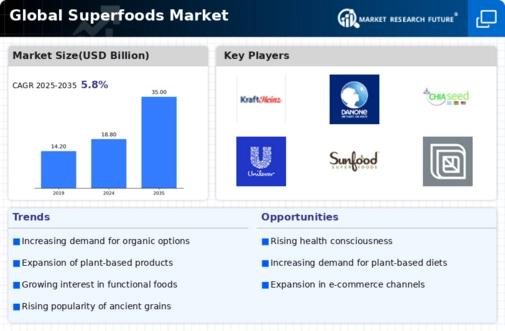E-commerce Expansion
The rapid expansion of e-commerce platforms has significantly influenced The Global Superfoods Industry. With the convenience of online shopping, consumers are increasingly purchasing superfoods through digital channels. This shift is supported by data showing that online sales of health foods have risen dramatically, with e-commerce expected to account for a substantial portion of the market share in the coming years. The accessibility of information and product reviews online also empowers consumers to make informed choices, further driving the demand for superfoods. As a result, The Global Superfoods Industry is likely to witness a transformation in distribution strategies, with brands focusing on enhancing their online presence.
Health Consciousness
The increasing awareness of health and wellness among consumers appears to be a primary driver for The Global Superfoods Industry. As individuals become more informed about the nutritional benefits of various foods, they are more inclined to incorporate superfoods into their diets. This trend is reflected in market data, which indicates that the demand for nutrient-dense foods has surged, with the superfoods segment projected to grow at a compound annual growth rate of approximately 8.5% over the next five years. Consumers are actively seeking products that offer health benefits, such as improved immunity and enhanced energy levels, thereby propelling the growth of The Global Superfoods Industry.
Diverse Product Offerings
The diversification of product offerings within The Global Superfoods Industry is another notable driver. Manufacturers are innovating and introducing a wide range of superfood products, including powders, snacks, and beverages, catering to various consumer preferences. This trend is evidenced by the introduction of new superfood blends that combine multiple ingredients, appealing to health-conscious consumers seeking convenience and variety. Market data suggests that the introduction of innovative products has led to increased consumer interest, with certain segments, such as plant-based protein powders, experiencing significant growth. This diversification not only attracts a broader audience but also enhances the overall appeal of The Global Superfoods Industry.
Influence of Social Media
The influence of social media on consumer behavior is a critical driver for The Global Superfoods Industry. Platforms such as Instagram and TikTok have become vital channels for promoting superfoods, with influencers and health enthusiasts sharing recipes and benefits. This trend has resulted in heightened visibility for superfood products, leading to increased consumer interest and purchases. Data indicates that products featured by influencers often see a spike in sales, demonstrating the power of social media marketing. As consumers increasingly turn to these platforms for dietary inspiration, The Global Superfoods Industry is likely to benefit from this trend, as brands leverage social media to reach target audiences effectively.
Focus on Clean Label Products
The growing consumer preference for clean label products is shaping The Global Superfoods Industry. As individuals become more discerning about the ingredients in their food, there is a marked shift towards products that are free from artificial additives and preservatives. This trend is supported by market data indicating that clean label foods are gaining traction, with consumers willing to pay a premium for transparency and quality. The demand for superfoods that align with these values is likely to drive innovation and product development within the industry. Consequently, brands that prioritize clean labeling are expected to thrive in the evolving landscape of The Global Superfoods Industry.


















Leave a Comment